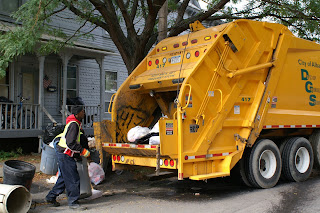
(i) Collection
“A number of different systems have been implemented to collect recyclates from the general waste stream. These systems tend to lie along the spectrum of trade-off between public convenience and government ease and expense. The three main categories of collection are “drop-off centres”, “buy-back centres” and “curb side collection”.
“Drop-off centres” require the waste producer to carry the recyclates to a central location, either an installed or mobile collection station or the reprocessing plant itself. They are the easiest type of collection to establish, but suffer from low and unpredictable throughput. “Buy-back centres” differ in that the cleaned recyclates are purchased, thus providing a clear incentive for use and creating a stable supply. The post-processed material can then be sold on, hopefully creating a profit. Unfortunately government subsidies are necessary to make buy-back centres a viable enterprise, as according to the United States Nation Solid Wastes Management Association, it costs on average US$50 to process a ton of material, which can only be resold for US$30.”
“Curb side” collection encompasses many subtly different systems, which differ mostly on where in the process the recyclates are sorted and cleaned. The main categories are mixed waste collection, commingled recyclables and source separation. A waste collection vehicle generally picks up the waste.
At one end of the spectrum is “mixed waste collection”, in which all recyclates are collected, mixed in with the rest of the waste, and the desired material is then sorted out and cleaned at a central sorting facility. This results in a large amount of recyclable waste, paper especially, being too soiled to reprocess, but has advantages as well: the city need not pay for a separate collection of recyclates and no public education is needed. Any changes to which materials are recyclable is easy to accommodate as all sorting happens in a central location.
In a commingled or single-stream system, all recyclables for collection are mixed but kept separate from other waste. This greatly reduces the need for post-collection cleaning but does require public education on what materials are recyclable.
Source separation is the other extreme, where each material is cleaned and sorted prior to collection. This method requires the least post-collection sorting and produces the purest recyclates, but incurs additional operating costs for collection of each separate material. An extensive public education program is also required, which must be successful if recycled contamination is to be avoided.
Source separation used to be the preferred method due to the high sorting costs incurred by commingled collection. Advances in sorting technology (see sorting below), however, have lowered this overhead substantially, many areas which had developed source separation programs have since switched to comingled collection.”
(ii) Sorting
Once commingled recyclates are collected and delivered to a central collection facility, the different types of materials must be sorted. This is done in a series of stages, many of which involve automated processes such that a truck-load of material can be fully sorted in less than an hour. Some plants can now sort the materials automatically, known as Single Stream. A 30% increase in recycling rates has been seen in the areas where these plants exist.
Initially, the commingled recyclates are removed from the collection vehicle and placed on a conveyor belt spread out in a single layer. Large pieces of cardboard and plastic bags are removed by hand at this stage, as they can cause later machinery to jam.
Next, automated machinery separates the recyclates by weight, splitting lighter paper and plastic from heavier glass and metal. Cardboard is removed from the mixed paper, and the most common types of plastic, PET (#1) and HDPE (#2), are collected. This separation is usually done by hand, but has become automated in some sorting centres: a spectroscopic scanner is used to differentiate between different types of paper and plastic based on the absorbed wavelengths, and subsequently divert each material into the proper collection channel.
Strong magnets are used to separate out ferrous metals, such as iron, steel, and tin-plated steel cans (“tin cans”). Non-ferrous metals are ejected by magnetic eddy currents in which a rotating magnetic field induces an electric current around the aluminium cans, which in turn creates a magnetic eddy current inside the cans. This magnetic eddy current is repulsed by a large magnetic field, and the cans are ejected from the rest of the recycled stream. Finally, glass must be sorted by hand based on its colour: brown, amber, green or clear.

Someone need to invent Wall-E...


No comments:
Post a Comment